They were up and about, getting ready for work. Parents were getting their kids out of bed, getting them ready for another school day.
But, in just a matter of minutes, the day was anything but just another spring day. For out of the darkness, from the west, came a tornado. And, when all was said and done, 12 of their neighbors and a sheriff's deputy from another county would be dead. Scores would be injured. And there would be millions of dollars in damage left behind to homes, businesses and schools.
The first indication that anything was wrong came about 6:30 a.m., when chatter on police scanners indicated that an officer was down west of Gainesville.
It turned out that the officer - a Dawson County sheriff's deputy - was the first victim of the storm. She was killed when she was hit by a car after she stopped to help a motorist involved in a weather-related accident.
From there, the storm skipped further into Hall County, heavily damaging Lanier Elementary School near Murrayville and killing a deliveryman as it tore across the school grounds.
"When I got there the truck was on a part of the building and the driver was still trapped inside," then-Hall County Superintendent of Schools Dennis Fordham recalled recently. "The left front portion of the building was extensively damaged."
A few seconds later, North Hall High School was hit. It, too, suffered heavy damage.
Fordham said as quickly as he could, he left Lanier to go to North Hall to survey the damage there. Most of the deaths occurred in that area - and included, Fordham said, a member of the school system family - "a retired custodian who lived adjacent to the school was killed as was one of his grandchildren."
It was also at North Hall that Fordham, now retired, got a first-hand glimpse of the fury of the story in a graphic way.
"(I saw) a piece of roofing material sticking out of the brick where it had been blow in at such high velocities."
Fordham said the school system did not fully recover from the storm until the the fall of that year and the start of a new school year. For the remainder of the term, some Lanier Elementary students attended classes at Sardis and Wauka Mountain elementary schools and even at Northlake Church, which is across the street from Lanier.
At North Hall, portable partitions were brought in and the gymnasium floor was turned into temporary classrooms. In addition, a system was devised whereby classrooms at the high school were used for classes during those times of the day when they were normally used by teachers for planning purposes.
The tornado and the death and destruction it caused was, Fordham said, a once-in-a-career thing - thankfully.
"We don't experience anything like that very often," he said, "never, never anything like that in my experience and, I think, in the experience of any of us who dealt with that at that time."
The twister left a trail of death and destruction between there and White County where several people were injured, one of them fatally.
AT THE COMMAND POST
Hall County Emergency Management Agency Director Elaine Sexton said her initial reaction to what she saw that morning was "feelings of shock. I really could not believe what I was seeing."
Hall County Fire Chief Mike Satterfield said he was at home at the time the storm struck, getting ready for work. He said he had just watched a weather report on television and didn't notice anything unusual, just a green area indicating some rain in Hall County. "The weather report caused no great concern, none at all." But shortly after that he got his first call about what had happened and immediately left for North Hall High School, where a command post had been set up in the parking lot.
"Initially our first concern was people who may have been injured or exposed to downed power lines and things of that nature and we were going about our business in a very routine type of way," Satterfield said. But, he added, that quickly changed and he was soon faced with the gravity of the situation.
"A lieutenant came up behind me...and said 'Chief, where can I put this child?' And, I thought "well, of all the things I need to address right now, I don't need to be a babysitter, so to speak, you need to take care of the child and not be asking those kinds of things.' And, my response was 'teachers and principals are here at the school, turn the child over to them.' And, he said, 'but chief,' and when he said that I turned around and looked and he had a stretcher with a sheet over it, and that's when, really, my heart went to my stomach and I knew we had fatalities and this was a much, much more serious storm than (we first thought)."
Satterfield said disaster drills don't fully prepare you to deal with the human element of something like a disaster of that magnitude. He said you can be as proficient as possible in your procedures and with your equipment, but the impact such an event has on people is hard to prepare for no matter how long you've been dealing with the bad things that happen to people.
Sexton agreed.
"The heartbreak of the people involved was the hardest part of it. The coordination of the search and rescue and recovery efforts was not that difficult because of the professionalism of the personnel involved and their training, and the help from neighboring counties. But the human side of it was hard on all of us."
It was difficult, Satterfield recalled, for many of his people and their equipment to get to the people who needed help.
""With the trees down and the power lines down, the roads were full of debris and that in itself caused the emergency crews a lot of problems."
He said, in many cases, they were having to cut trees out of the roadway before they could go into an area.
"One fire truck was caught in the tornado and a tree was blown over the cab, injuring the two fighters (inside) slightly. A byproduct of a tornado is a roadway that has debris that is full of nails. We had about a dozen flat tires on emergency vehicles (because of that)."
Sexton and Satterfield said off-duty emergency personnel - fire, EMS, sheriff's deputies, 911 operators, etc. - responded, in large part, without having to be called. They heard about what was going on and showed up ready to go to to work, he said.
"And, not just the ones here in Hall County, but the neighboring communities as the word went out and the news was heard; we turned around and they were there."
A lot has changed in Hall County and the rest of the state in the way the public is alerted to National Weather Service severe weather warnings. Radio and television still play a big part in getting the word out. But now there's the Internet, through which messages can be instantly transmitted to a desktop computer, a PDA or a cell phone. In addition, the Georgia Emergency Management Agency (GEMA) and the National Weather Service, within the first five years of the tornado, implemented a number of measures that were designed to improve word of weather watches and warnings.
"At that time there were parts of the state that had no weather radio coverage," Sexton said. "But that has changed. We now have statewide coverage, thanks to a tremendous undertaking by the GEMA and the National Weather Service."
Five years after the storm, a county-wide siren warning system had been installed in Hall County and, Satterfield said, more people had weather radios in their homes. By 2003, a new weather radio transmitter had been installed on Wauka Mountain on the Hall-White county line - "a very strong one," he said - which "now covers all of the county."
In addition, the National Weather Service, Sexton said, has improved its ability to spot problems on radar and get the word out. But the system is not perfect, she said, "so when you combine the sirens and the NOAA weather radios with the better product that we're getting from the National Weather Service, then, it just makes for a better warning system."
But, no system is perfect.
"Unfortunately that was true then and it is still true now," Sexton said.
THE VICTIMS
John Sullens was still at home when the twister struck.
He told reporters that fateful day that he felt the house shake and "the next thing I knew I was flying through the air and hitting the wall, wondering if I was going to be alive or dead in the next few minutes. The house was completely torn apart. I hit the wall."
Ann Ravan was trying to get in touch with her daughter when she stopped to talk with reporters.
"There's trees everywhere. Her house is a total loss. Both their vehicles are a total loss. I just need to get home and tell her and let her know there's not much to come home to."
John Shope was luckier.
"Fortunately, in this case, there were no injures. It came from the north, I guess, and I live on Newton Drive just off of highway 60 (Dahlonega Highway) and we were right in the path of it, I guess."
Michelle Robinson's description of the approaching storm was "classic tornado."
"I just heard an awful sound, like a train," she said.
Rev. Ron Woslid described it this way: "It was a real, real loud, loud noise. And, it happened fast."
One man described how the windows were blown out of his house while noting that he was better off than his neighbors. "Glass was stuck in the roof and the walls and blown across the room," the man said. "They have an open house now. There are no walls left but they are alright."
Hazel Swindoll lived in one of the many mobile homes damaged or destroyed. Four days after the tornado she was already looking forward to getting into her new home. But she was emphatic that it was not going to be another mobile home.
"We are going to build a house. Starting sometime this week, we are going to build a house. We're not going to buy another mobile home. We're going to build a house," she said.
An untold number of children were impacted by the storm. Some were injured. Some lost classmates to the twister. Some had their homes damaged or destroyed. A few days after it hit, Quint Morris talked about the impact on his daughter.
"I don't know whether she understands it all or not," he said. "It's been traumatic for her to say the least but she's handling it well."
Another man described how he and his wife prayed as the storm bore down on their home. "We got up, realized that was moving in and getting louder and louder," he recalled. "The wind had kind of picked up and we just went into the kitchen and (got) under the table and started praying. And, we had just started praying and it (the wind) just ceased."
STATE AND FEDERAL HELP
The state and federal governments quickly mobilized to send help to the devastated areas - and James Witt, then the head of the U.S. Emergency Management Agency - personally surveyed the damage in the days after the storm. Then-President Bill Clinton quickly issued a federal disaster declaration, making those whose homes and businesses were damaged or destroyed eligible for low-interest loans to help them rebuild or repair and to expedite the use of federal resources in the clean-up.
Then-Gov. Zell Miller surveyed the damage by helicopter just hours after the storm struck. Later he discussed the situation with reporters, telling them, "I cannot believe the devastation that I saw. It has touched the lives of these people in these five counties in a horrible way."
Within hours and days, shelters had been set up for the homeless. Food, clothing and building materials began rolling into the area from all over the state. Special blood drives were held to help replenish supplies left short by blood used to help treat those who had been injured. Special accommodations were made to get prescription drugs to those who had lost theirs during the storm.
Then-Sen. Max Cleland toured the area, as well. "I would say that looks like a real war zone to me. Thirty years ago I was in Vietnam and I haven't seen such devastation since then," he said.
In Hall County, the storm's direct hit on the North Hall area came close to home in a very personal way for Congressman Nathan Deal.
"This (North Hall area) is my home," he said two days after the twister hit. "This is my community and while I'm the congressman that represents the five counties that are primarily affected here, this is the school where my children were educated, this is the school area where my wife teaches school. She was on her way to school when this tragedy occurred."
Miller noted that "long after the (news) cameras have faded and the reporters go home, there's still going to be an awful lot of work to be done and I want you to know that we're (government officials and agencies) in it for the long haul."
Deal added: "The real heroes, I think, of this event, have been the neighbors and the family and the friends who have shown more than you could ever expect in terms of understanding of the devastation."
GETTING THE WORD OUT
The job of getting the word out to an anxiously waiting community, as well as the nation and the world, fell primarily on the shoulders of Kate Maine. Maine was the public information officer for Hall County government and had been on the job "just a few months."
Maine had a strong personal tie to the North Hall area at the time, and was wondering during the first few hours after the storm about the safety of her parents.
"My parents lived very near North Hall High School," she said. "In fact, at the time, my mother taught at North Hall Middle School."
Before long, she learned that they were both OK.
Maine found herself that morning suddenly the link to the outside world - the person reporters turned to for information.
Not just local reporters but reporters - radio, television, newspaper - from Atlanta, of course. But, also places like Augusta and Greenville, S.C.
All the major broadcast networks covered the story - ABC, CBS, NBC - as did the cable news networks in operation at the time. Maine recalled recently that an Australian television crew also showed up. It had been tracking the storm system across the county "for another project," she said.
It was Maine who, as official spokeswoman for the county, met with the reporters and briefed them time and time again on the latest information on fatalities, injuries and the scope of damage. Those briefings usually occurred at North Hall High School, where a command post had been set up by the agencies involved in the damage assessment, plans for clean-up of the area, getting help to those left homeless, etc. She scheduled news conferences by county officials such as EMA director Elaine Sexton, fire chief Mike Satterfield and county commission chairman Al Gainey.
What were the hours and days immediately after the tornado like?
"Everything seemed to happen very quickly," she said, "but at the same time, things were almost in slow-motion."
It was a daunting task and a frustrating one, at times, she recalled - because of the demands placed on her by some reporters who were a little overly aggressive in seeking information for their stories - and access to the survivors.
"I felt very protective of the victims of the storm," Maine said.
Maine, now the public relations director for Riverside Military Academy, said it was a demanding time, both physically and emotionally.
"I look back on it with just a lot of respect for the people that I met and encountered at that time," she said.
And, Maine said she feels she's a better person, both professionally and personally, for the experience.
It would be several months before life as we had known it returned to our area. The debris left behind by the storm is long gone; the structures damaged or destroyed, rebuilt and repaired in most cases. But for those directly touched by the storm, the emotional, and in many cases, physical, scars remain 10 years after the twister.
On Thursday, a memorial service is to be held at noon in Clermont at Clay E. Gailey Park for the victims of the tornado.
WEATHER SERVICE REPORT
A report issued by the National Weather Service (NWS) two months after the twister concluded that it traveled 11.5 miles through northern Hall County into southern White County. Its path was up to one-quarter of a mile wide.
In its wake, 12 fatalities were directly related to the tornado, the report said. Eleven of them occurred in mobile homes. Eleven of them were in Hall County, with the remaining one in White County. The twelfth was the truck driver whose vehicle was blown into Lanier Elementary School. One additional indirect fatality occurred when a sheriff's deputy stopped to help with a weather-related traffic accident and was hit by a passing car and killed.
Hall County reported 96 injuries, while White County reported 75.
In Hall County, according to the NWS report, 30 homes were destroyed with 105 damaged. Damages in Hall County were estimated at around $13.5 million. Damage in White County was estimated at $1.7 million, with 22 homes destroyed and nine damaged. Thirteen mobile homes were destroyed, with nine damaged.
(Though not included in the NWS report, several poultry farms were also in the path of the storm and a number of poultry houses were flattened by the winds. Thousands of chickens were killed and thousands injured. A number of cattle was also killed).
The report goes on to say, "one of the main concerns about this tragedy was the lack of a warning from the Peachtree City (NWS) office prior to the onset of the tornado. A severe thunderstorm watch for the area had been issued at 12:45 a.m. but was allowed to expire, as scheduled, at 6: a.m. A severe thunderstorm warning was issued for Hall County at 6:46, about 20 minutes after the tornado struck and about the time the NWS began receiving first reports that the twister had touched down. Because of those reports, a tornado warning was posted at 6:51 for White County."
HISTORY
This was not the first time Gainesville has been struck by a killer tornado.
On April 6, 1936, a storm leveled the downtown area, killing 203 people and injuring 1,600. It, too, struck in the morning, when many people were on their way to work or school or had just arrived there. Some reports said debris was stacked 10-feet deep in the street. Fires broke out. The highest number of fatalities in a single building occurred at the Cooper Pants Factory, where 70 people lost their lives.
A tornado that hit Gainesville in 1903 killed about 100 people and caused damages placed at $750,000 in 1903 dollars.
For information about tornadoes and tornado safety tips, go the Web site listed below.
U.S Storm Prediction Center. http://www.spc.noaa.gov/faq/tornado/safety.html
(A number of former Jacobs Media Corp. employees contributed to this story through archived material. Among them: Kathy Kuss, Dave Hadary, Scott Grant, Garry Glenn and the late John Parks. There were, no doubt, others, and we apologize for any omissions).
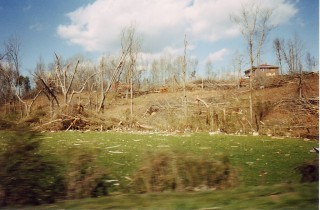
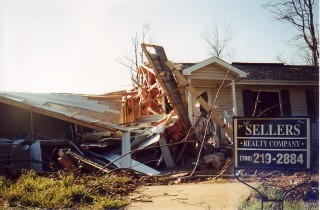
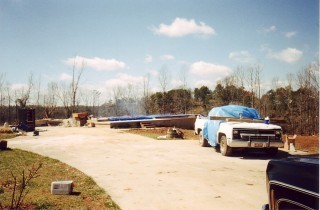

Photos by Scott Cagle

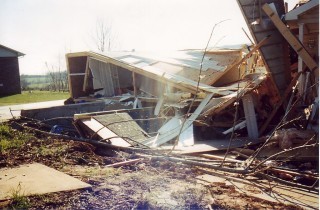
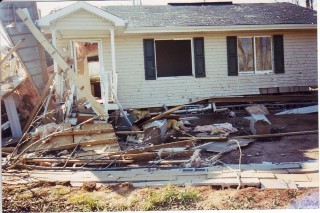
http://accesswdun.com/article/2008/3/207899
